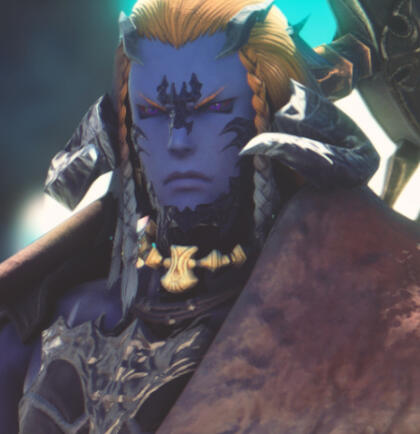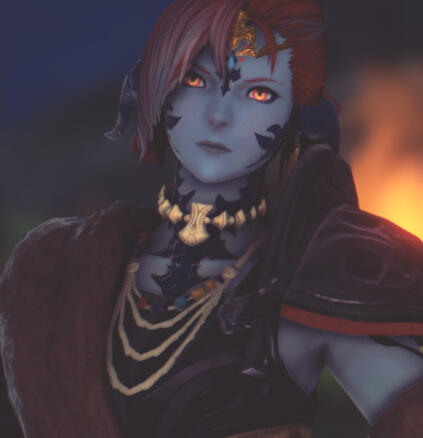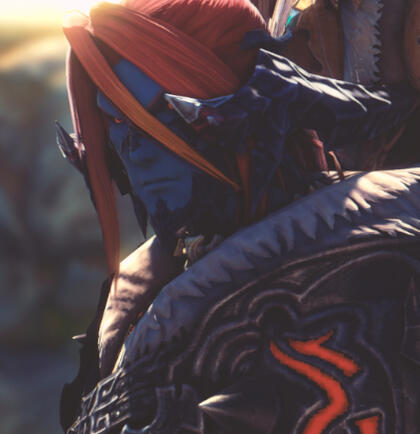
Temürdai Clan
Qerel Tribe

"There are spirits all around us. All we must do is listen."
Basic Information
Clan Name:
Tribe
Territory:
Tongues:
Type:
Patron Deity:
Governance:
Khan:
Temürdai
Qerel
Northwestern Plains, Azim Steppe
Old Xaelic, Qerel Xaelic
Nomadic
Nhaama
Khanate
Tokhta Qerel
Characteristics
Physical Characteristics
Though invariably sharing the base coloring of hair and skin common to the Xaela, both male and female Qerel of the Temürdai clan tend to be on the taller side for their people. Clan legends say it is because long ago they once ranged across the mountain valleys of the steppe, and became hardier stock for it.
Clothing
Those of the Temürdai clan primarily dress in shades of red, black, and grey, their clothes colored with dyes crafted by the artisans of the clan. Like all Xaela, they utilize the nautral fauna of the steppe in the making of their garb, and as Qerel, steppe tigers are a common source of material.While the warriors fashion armor from the tiger's bones, their hides are often distributed to the wider clan and used for other clothing. Other animal hides common in their dress include those of dzo, gulo gulo, and horse.
Culture
The Temürdai clan has existed for thousands of years and hundreds of generations, their strength allowing them to survive in the unforgiving fields of their homeland. As such, they have a rich cultural history and a number of traditions that shapes their way of life and informs their outlook on the world.
Territory
Like the majority of all Xaela, the Temürdai are nomadic, and do not maintain permanent settlements. However, given the massive expanse that is the Azim Steppe, they prefer to center their wanderings in the northwestern plains, while in ancient times they roamed the great mountains of the north. Their migrations come with the changing of seasons, with summer being the longest and winter the shortest.In the months-long periods between their wandering, they prefer to establish their yurt camps with the greater whole of the Qerel tribe, both for protection and communal sharing of resources. At times, when apart from their other tribe kin due to a storm or other circumstance, they will make a yurt camp with others of a different clan or tribe which which they have friendly relations.
Rites and Rituals
Falconry
Temürdai hold many animals as sacred and chief among them the falcon, second only to the mighty steppe tigers. These raptors are considered symbols of bravery, winged warriors to be admired and emulated, with larger birds considered to be of immense spiritual power. As such, falconry is a common practice, shared by Temürdai of all stations.Temürdai hunters train them to assist in tracking and retrieval of small game, while warriors train them to become scouts upon the battlefield, as well as skilled skirmishers that utilize wing and talon to disable the enemy. Other Temürdai train them for a variety of simple tasks, while some simply keep them as loyal companions.
Blood Soul
Temürdai believe that souls reside in the physical form of blood, which they simply refer to as the "blood soul". Each being has an indeterminate number of souls, and the way of one's death can determine what might happen to these myriad of souls.For those of great renown or lived an honorable life in service to both the clan and tribe, their souls transmute into birds and fly to their afterlife in the embrace of the Dusk Mother. The souls of clan leaders, great warriors, and shaman may choose to remain in the land as ancestral spirits. Those who are particularly wicked or have their blood spilled in dishonor, their souls may be kidnapped by evil spirits. Others still may require the aid of a ritual to send their soul to its proper destination.A soul taken captive becomes a ghost and can be used for dangerous shamanic rites against relatives and foes. If freed, the ghost will still wander the land until captured again or sent on by a proper ritual. Souls can be recaptured from the blood of the slain or by special mystical traps. Due to this, it is a widespread practice among the Temürdai to swear a blood oath as a symbol of loyalty, and this oath is particularly dangerous and evil to break, as it mingles souls together.Temürdai often utilize the blood of their fallen kin to dye their armor, clothing, weapons, and other possessions, believing that by doing so, a portion of their souls will remain with them, and both preserve their memory and watch over them from the afterlife in a protective fashion.
Drums
While Temürdai do not have an expansive musical tradition as other Xaela clans and tribes, they maintain an ancient tradition of utilizing drums in communication, entertainment, religious ceremonies, and war. They have two primary types of drums, a frame drum known as a tuur and a two-headed drum known as a damar.Tuur are made from rawhide and bone, most often from the steppe tigers, and come in a variety of sizes depending on their primary use. Smaller tuur are struck with the hand, while larger ones utilize a heavy stick made from bone or wood. These are the primary drums utilized by the clan to communicate during wanderings, and by hunters and warriors while in the field. The smaller tuur are played during festivals, and their songs tend to be heavy and fast.Damar are exclusively used in religious ceremonies, where they are played by shaman. They are constructed from the same rawhide and bone as the tuur, but do not have the same variance in size. A band of silk is affixed in the middle of the drums, with bone beads affixed to string. When the drums are moved back and forth, the beads strike them, thus producing the percussive sound.
Herd
The Temürdai keep a herd comprised primarily of both dzo and horse, and while somewhat smaller than the herds of the larger tribes that dominate the steppe, their herd is sizable and filled with strong horses and bountiful dzo.Temürdai believe that the horses that comprise their herd are capable of running on the wind and jumping higher than their sun, and the many powerful bloodlines are symbols of the spiritual strength of their steeds. They have similiar beliefs towards their dzo, as their great bounties are thought to be blessings from the spirits of the land.
Religion
Nhaama, the Dusk Mother, is the paramount deity in Temürdai clan worship, as is true for a great many of the Xaela tribes. The Temürdai also have a long tradition of animism, dating back to when they first roved across the mountains of the steppe.They hold that there are two types of prime spirits, each representing an aspect of the Dusk Mother herself - white spirits that are benevolent in nature, and black spirits that are vengeful. Beneath these spirits are ancestor spirits and protector spirits, ancestor spirits being the spiritual souls of Xaela that have died and returned to the land, and protector spirits the spirits of the Azim Steppe itself, found in everything from flora to fauna.Temürdai shaman can call upon these spirits for guidance, or for assistance in war. The Temürdai also have a series of mound-like altars called ovoo throughout their typical ranging territory that shaman are duty-bound to maintain, lest they anger the spirits.
Cuisine
Culinary Traditions
The continental climate of the Azim Steppe has influenced the traditional diet of the Xaela, and the Temürdai are no exception.Temürdai primarily cook their food in an iron pot on a small hearth fire stove, using wood or animal dung as fuel, which they call argal. Yurts designated as guanz are known by Temürdai and other Xaela as yurts that function primarily as what those in other areas of the world would consider to be restaurants, though much simpler in nature.During festivals and other special ceremonies, a second method of food preparation is utilized. Stones are heated atop a burning fire, and the meals are cooked inside the abdominal cavity of a deboned animal.
Ingredients
The primary proteins used in Temürdai cooking are those that come from their herd or the local fauna that roams the plains of the northwestern steppe. Dzo, horse, steppe tiger, and mutton are the most common meats, often made into a type of dumpling known as buuz. Other dishes include stews or noodle soups, and they keep stores of salted meats in the case of scarcity of game.Due to the scarcity of native flora, vegetables and spices are limited, but food and drink made from the milk of dzo is incredibly common. Temürdai are known for their treats made from soured dzo milk and several types of dzo's milk cheese of varying flavors and textures. Other common accompaniments to their dishes include rice and noodles made from the flour of barley.
Clan Structure
Clan Leadership
The Temürdai are led by a clan chieftain which they refer to with the customary Xaela titles of khan or khatun, depending on the gender of the chieftain. Unlike the khagan of the Xaela which is decided by the Naadam, the khan or khatun of the Temürdai is a hereditary position, a tradition dating back to when they roamed the northern mountains of the steppe. The current khanate bloodline is that which can trace their ancestry to Temürdai Qerel, founder of the clan.While the chieftain of the Temürdai is nominally subservient to the khan or khatun of the Qerel tribe, in practice the Temürdai chieftain has the final say on matters related to the clan. Most often this includes settling interclan disputes, and deciding on political interactions with outsiders and those of other Xaela clans or tribes.
Shaman
Next to the khan or khatun, the most respected of the Temürdai are the clan shaman, known as _ böö_ for male shaman or udgan for female shaman. These shaman interpret the words and signs of the Dusk Mother and speak with her voice, as well as communing with spirits and advising the clan chieftain.Shaman have a number of clan duties, which include leading religious ceremonies, performing rituals and sacrifices, tending to the ovoo, and other traditional practices. Temürdai shaman practices vary by training, the most traditional practicing black shamanism, while others practice white or yellow shamanism, which blends traditions from shaman of other clans. No matter their training, all shaman are devoted utterly to the spiritual well-being of the clan.
Warfare
Weaponry
The Temürdai are fierce warriors, and will defend their herd and territory to the last breath. As they often range intermingled with the larger Qerel tribe, their warriors are always the first to rush to the front lines, preferring to wield powerful axes and spears in battle. Recurve bows made from a composite of wood, dzo horn, and sinew are the favored weapons of their hunters, and are frequently carried into battle.The Temürdai are best known, however, for the bestial rage of their spirit warriors. Many weaker tribes who have attempted to raid their territory have quickly learned their lesson, falling swiftly beneath the might of these furious combatants.
Ongon Daichin
Long ago, a warrior amongst the Temürdai Clan was born with the Will of Karash, and instead of exiling himself and joining the Chaghan Tribe, he resolved to find a way to control it. Together with a clan shaman, he consulted the spirits of the Steppe and they revealed to him an ancient art of spirit binding, a gift from the Dusk Mother long thought lost.Remembering the fury of the steppe tigers in battle, he traveled to a mountain pass and found a particularly large breed of tiger. He killed one of these beasts and used the ritual to bind its spirit to himself, which gave him a channel for his fury. Ever since, this tradition has been passed down through the Temürdai Clan, and those who undertake this ritual are known as ongon daichin - or 'spirit warriors' in Eorzean - and many fear them across the steppe.
Tribal Relations
Qerel to the end, the Temürdai are therefore a warlike clan, though their thirst for battle is less than that of such tribes as the Dotharl. There is no one particular tribe they view as their enemy, though they have battled against the Dataq, Bayaqud, and Malqir tribes over territory and herds. Animosity isn't kept for long, as they have also found themselves engaging in trade with the very same tribes.The tribe that the Temürdai interact with the most are the Qalli, and it is with them that they have a mostly cordial relationship. Trade is common, and the songhealers of the Qalli clan Shidet Tarni have been known to mend the wounds of wayward Temürdai warriors. Spirit and blood oaths are also common between them, sworn in the presence of spirits to ensure they are kept.
Clansfolk
Tokhta Qerel
Khan

Tokhta Qerel is the implacable Khan of the Temürdai clan. A fearsome warrior and steadfast ruler, Tokhta is a direct descendant of Temürdai Qerel, ancestral forefather of the clan. He has ruled the Temürdai for many years, and under his rule, the Temürdai have continued to prosper despite the unforgiving nature of the Steppe.
Ibaakha Qerel
Udgan

As the wife of Tokhta, Ibaakha bears the title of Khanum of the Temürdai, though she considers herself udgan before all. As shaman, it is her duty to commune with the spirits of the Steppe and guide the Temürdai on their journey of balance, and she is always beside her husband as his most trusted advisor.
Baatar Qerel
Khanzadeh

Baatar is the son of Tokhta and Ibaakha, and is the greatest warrior of the Temürdai. He is an ongon daichin, a warrior who bears the spirit of a Steppe tiger within him, and able to channel its fury in battle. As Khanzadeh of the Temürdai, he will one day assume the title of Khan from his father, and lead his clan to further glory.










